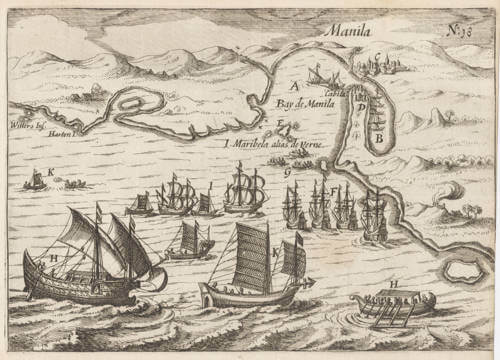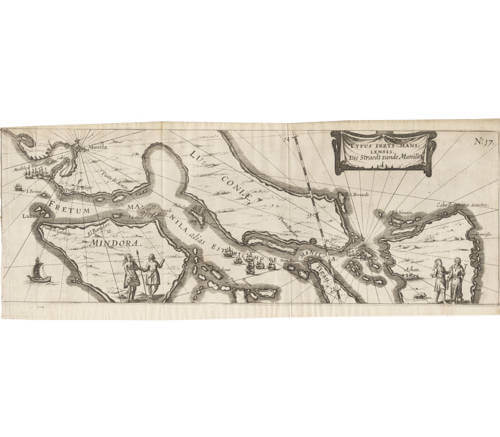Leen Helmink Antique Maps
The second map of Guam - Mariana Islands
The item below has been sold, but if you enter your email address we will notify you in case we have another example that is not yet listed or as soon as we receive another example.
Stock number: 19455
Zoom ImageCartographer(s)
Joris van Spilbergen (biography)
Title
I. Ladrones
First Published
Leiden, 1619
This Edition
Amsterdam, 1646
Size
15.0 x 21.2 cms
Technique
Condition
excellent
Price
This Item is Sold
Description
One of the earliest obtainable printed views of Guam.
The expedition of Van Spilbergen stays at the Ladrones
While crossing the Pacific Ocean, Joris van Spilbergen’s fleet stopped at the Ladrones islands in January 1616. Today they are the Mariana Islands. The fleet stayed here to collect fresh supplies, which were sorely needed. A number of people had died during the voyage across the Pacific. At the islands the fleet was welcomed, however, and succeeded in bartering for supplies.
The image shows the events at the Ladrones:
A. is the Admiral’s ship the Sun.
B. is the vice-admiral’s ship the Moon.
C. is the Morning Star.
D. is the Aeolus of Rotterdam.
E. is the Hunter.
The people of the island visited the ship in such great numbers in their canoes that the author likens them to a “swarm like bees”.
F. is a ship captured by the fleet at South America.
G. shows the canoes of the people of the Ladrones.
H. are the canoes that were used to sail in the Ladrones.
I. depicts the indigenous people of the Ladrones.
(Atlas of Mutual Heritage)
The view was issued in 1619 in Spilbergen's rare Journal of his own voyage, published in combination with the Journal of Jacob Le Maire's voyage of 1615-17 that discovered Strait Lemaire and Cape Horn, an alternative a route that avoided the Strait and the VOC monopoly.
Oost ende West-Indische Spiegel der 2 leste navigatien ghedaen inden jaehren 1614. 15. 16. 17. ende 18, daer in vertoont woort in wat gestalt Ioris van Speilbergen door de Magellanes de werelt rontom geseylt heeft ... Met de Australische navigatien, van Iacob le Maire, etc.
[ The East and West Indian mirror, being an account of Joris van Spilbergen's voyage round the world (1614-1617), and the Australian navigations of Jacob Le Maire ]
Condition
A strong and even imprint of the copperplate. Minor loss to the left margin not affecting the print. Overall a near pristine example of a rare collector's item.
Joris-van-Spilbergen (1568-1620)
Joris van Spilbergen (1568, Antwerp – 1620, Bergen op Zoom) was a Dutch naval officer.
His first major expedition was in 1596, when he sailed to Africa.
In 1601 he left for Asia, in command of the fleet of the company of Balthazar de Moucheron (a trading company before the establishment of the VOC). Spilbergen met the king of Kandy (Sri Lanka) Vimala Dharma Suriya in 1602, and discussed the possibility of trade in cinnamon.
In 1607, Spilbergen was with Jacob van Heemskerk at the Battle of Gibraltar.
From 1614 to 1617 he circumnavigated the world, sailing through the Strait of Magellan with an expedition of five ships. He raided Spanish settlements on the coasts of Mexico and South America. He fought the Spanish at Callao, Acapulco and Navidad. He captured the pearl fishing ship San Francisco at Zacatula. He then sailed across the Pacific Ocean to the Mariana Islands, the Philippine Islands and eventually to Ternate in the Moluccas Islands in March 1616. He returned to the Dutch Republic in 1617, sailing westwards.
He died a poor man in Bergen op Zoom in 1620.
(Wikipedia)
The voyage to South America and around the world of Joris van Spilbergen 1614-1617
In the early 1600s, the new established VOC had the Dutch monopoly for all trade in Asia. The company experienced stiff competition from the Spanish and Portuguese, with which the Dutch Republic was at war. Despite the Twelve Year Truce (1609-1621) armed conflicts in the states’ colonial possessions continued. In this light, the VOC sent out an expedition under Joris van Spilbergen in 1614. Its objective was to sail through the Strait of Magellan in South America and then to sail along the Southern American and Central American coast to harass Spanish holdings there and to capture ships carrying Spanish or Portuguese goods.
The expedition first sailed sailed to the Cape Verde islands and via the western coast of Africa it reached Brazil. Van Spilbergen tried to acquire supplies at São Vicente, but was refused by the local governor. Some illicit trade with local Portuguese took place, but Van Spilbergen became suspicious that he was being held up for a potential attack on his ships. He seized a Portuguese vessel, but attempts to negotiate his prisoners for supplies failed. He released the prisoners and sailed on. The expedition stayed at Porto Desire for a few weeks and then tried to enter the Strait of Magellan. Several ships however, struggled to enter the Strait. Here, a mutiny broke out on the Meeuw, which had given trouble already several times earlier in the voyage and the ship was eventually lost and departed the fleet.
In May 1615 the expedition reached the Pacific Ocean and sailed up the Chilean coast. Van Spilbergen hoped to capture Spanish ships carrying valuable cargo. At La Mocha, friendly trade was accomplished with the locals. At nearby Santa Maria, hostilities broke out and the Dutch razed and plundered the island. Van Spilbergen continued further north to Valparaiso and Arica, without achieving much. In mid-July a Spanish fleet under Da Mendoza, sent to intercept Van Spilbergen, found the Dutch ships and a night time battle broke out. Van Spilbergen’s fleet fought off the Spanish attack and after two days of fighting several Spanish ships were destroyed and the rest fled.
Van Spilbergen then continued sailing further north, but failed to capture any ships carrying Spanish silver. The fleet raided and destroyed the town of Payta in modern-day Peru. Further north, they exchanged prisoners for supplies at Acapulco in Mexico in October. Soon after, the expedition turned west to cross the Pacific. The fleet reached the Philippines in February 1616. After hearing that a large Spanish fleet was on its way to the Moluccas, he decided to pursue them. It later turned out that the Spanish armada was headed to Malacca instead. At the end of March Van Spilbergen reached Ternate, where some of the ships and Van Spilbergen assisted the commander Laurens Reaal in an expedition against the English. In July, Van Spilbergen decided to depart for Java, from where he sailed to the Netherlands. He arrived home on 1 July 1617.
(Atlas of Mutual Heritage)



